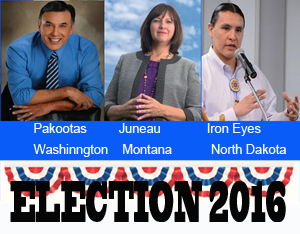 In the 2016 elections, Denise Juneau, Joe Pakootas and Chase Iron Eyes are blazing a new trail.
In the 2016 elections, Denise Juneau, Joe Pakootas and Chase Iron Eyes are blazing a new trail.
THE Ave endorsed Joe Pakootas for Congress. We did that after hearing this remarkable man speak. Joe seems like an ideal candidate for the eastern side of our state, a region with very traditional fiscal conservatives but also very traditional respect for a self made man.
There is another issue here our deep roots in the indigenous peoples of our State .. the Lummi, Puyalup, Makah.the Colville, others. We were lucky not to have indian wars here, lucky but also fortunate that the settles came to a place that treasured values very simialr to values the new Americans had … respect for others, love for the land, a very multicultural community, and a raw determination to succeed.
I really had not thought all that much about the significance of Joe as a Native American. I should have.
Joe is one of three native Americans running as new candidates for Congress. These Democrats would add a congressional constituency of one, two or three Native Americans, a Colville, a Blackfoot, and a Lakota to the existing Republican community from Oklahoma, two US representatives, Markwayne Mullin, a member of the Cherokee Nation, and Tom Cole, of the Chickasaw.
Passions are running high, like the first race of African American politicians.
Two of these Democrats are running in states that are part of where I live, the Pacific Northwest.
Montana has been red for a long time .. in this case “red” means Republicans reflecting the conservative culture of farmers and ranchers. That tradition, however, has never had the racist and xenophobic taint that now afflicts Trumps’s GOP, Montana has elected very impressive Democrats as governors and senators. who fit the state’s conservative culture. Now Montana is on the 2016 “Red to Blue” list, a Democratic list of traditionally Republican states the party hopes to win in its bid to take the House as well as the White House.
Washington is already blue because of Seattle but Eastern Washington has a deep red association with the birth of the John Birch Society in eastern Washington and the roots of the Aryan Brotherhood in nearby Idaho. Pakootas’ opponent, Kathy McMorris Rogers is a semi literate Tea Party activist, is the fourth ranking Republican no the house and a committed Trump supporter. Pakootas grew up the hard way, realizing what conservatives still see as the American dream. As a businessman he took the Colville businesses out of bankruptcy to a solid financial basis. A Pakootas win will bring the 5th Congressional District a Colville Indian with a huge record of hard headed success as a businessman to office.
Juneau’s story is a lot like Pakootas’ story. She was brought up in the small, hardscrabble town of Browning, on the Blackfeet reservation at the edge of Glacier National Park. She describes herself as a native of the area “going back 54 generations” – long before it was called Montana by explorers. She served as Montana schools superintendent, and raised high school graduation rates from 80% when she took office in 2009 to 86% last year. If Juneau wins , she will hold Montana’s only seat in the House of Representatives. Juneau has been Montana’s education superintendent since 2008, and as such the first Native American woman in the US elected to statewide office. In contrast, her opponent is a lot like Kathy McMorris Rogers. A far right radical. Ryan Zinke, was only elected in 2014. He is vigorously, stumping for Trump, and even suggested himself as a possible vice-presidential candidate.
Juneauy and Pakootas are not alone. In addition to a Cherokee and a Chikashaw already serving as Representatives of Oklahoma, Chase Iron Eyes is running as a Democrat for North Dakota’s only US House seat. Iron Eyes is a member of the Standing Rock Sioux, the tribe at the center of the successful oil pipeline protest. When the federal government ordered a temporary halt to construction on the pipeline, a little over a week ago, Iron Eyes said the issue went beyond indigenous interests over threats to water supplies and implicated “systems that assume the Earth’s resources are limitless”. He also pointed out that members of 140 tribes had been counted at the protest camp: a huge turnout.
Robert Holden, a Native American activist asked, “Can you imagine if we could get [the Native American vote] up to 75%? It would be amazing. We would knock the lights out.” Native Americans make up 1.7% of the US population – alone, they are not going to be decisive in sending Trump or Hillary Clinton to the White House. Nonetheless, the surge in the number of candidates and likely voter interest make this a watershed year.